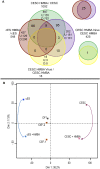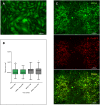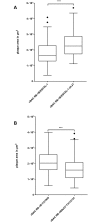ESCDL-1, a new cell line derived from chicken embryonic stem cells, supports efficient replication of Mardiviruses
- PMID: 28406989
- PMCID: PMC5391029
- DOI: 10.1371/journal.pone.0175259
ESCDL-1, a new cell line derived from chicken embryonic stem cells, supports efficient replication of Mardiviruses
Abstract
Marek's disease virus is the etiological agent of a major lymphoproliferative disorder in poultry and the prototype of the Mardivirus genus. Primary avian somatic cells are currently used for virus replication and vaccine production, but they are largely refractory to any genetic modification compatible with the preservation of intact viral susceptibility. We explored the concept of induction of viral replication permissiveness in an established pluripotent chicken embryonic stem cell-line (cES) in order to derive a new fully susceptible cell-line. Chicken ES cells were not permissive for Mardivirus infection, but as soon as differentiation was triggered, replication of Marek's disease virus was detected. From a panel of cyto-differentiating agents, hexamethylene bis (acetamide) (HMBA) was found to be the most efficient regarding the induction of permissiveness. These initial findings prompted us to analyse the effect of HMBA on gene expression, to derive a new mesenchymal cell line, the so-called ESCDL-1, and monitor its susceptibility for Mardivirus replication. All Mardiviruses tested so far replicated equally well on primary embryonic skin cells and on ESCDL-1, and the latter showed no variation related to its passage number in its permissiveness for virus infection. Viral morphogenesis studies confirmed efficient multiplication with, as in other in vitro models, no extra-cellular virus production. We could show that ESCDL-1 can be transfected to express a transgene and subsequently cloned without any loss in permissiveness. Consequently, ESCDL-1 was genetically modified to complement viral gene deletions thus yielding stable trans-complementing cell lines. We herein claim that derivation of stable differentiated cell-lines from cES cell lines might be an alternative solution to the cultivation of primary cells for virology studies.
Conflict of interest statement
Figures









Similar articles
-
Keratinocytes derived from chicken embryonic stem cells support Marek's disease virus infection: a highly differentiated cell model to study viral replication and morphogenesis.Virol J. 2016 Jan 7;13:7. doi: 10.1186/s12985-015-0458-2. Virol J. 2016. PMID: 26742789 Free PMC article.
-
Efficient Marek's disease virus (MDV) and herpesvirus of turkey infection of the QM7 cell line that does not contain latent MDV genome.Avian Pathol. 2014;43(5):414-9. doi: 10.1080/03079457.2014.956687. Avian Pathol. 2014. PMID: 25204414
-
Quail cell lines supporting replication of Marek's disease virus serotype 1 and 2 and herpesvirus of turkeys.Avian Dis. 2004 Dec;48(4):803-12. doi: 10.1637/7182-032604R. Avian Dis. 2004. PMID: 15666861
-
Marek's disease virus: lytic replication, oncogenesis and control.Expert Rev Vaccines. 2006 Dec;5(6):761-72. doi: 10.1586/14760584.5.6.761. Expert Rev Vaccines. 2006. PMID: 17184215 Review.
-
Marek's disease virus research in the post-sequencing era: new tools for the study of gene functions and virus-host interactions.Avian Pathol. 2003 Aug;32(4):323-33. doi: 10.1080/0307945031000121068. Avian Pathol. 2003. PMID: 17585455 Review.
Cited by
-
Marek's Disease Virus Virulence Genes Encode Circular RNAs.J Virol. 2022 May 11;96(9):e0032122. doi: 10.1128/jvi.00321-22. Epub 2022 Apr 12. J Virol. 2022. PMID: 35412345 Free PMC article.
-
The pUL51 Tegument Protein Is Essential for Marek's Disease Virus Growth In Vitro and Bears a Function That Is Critical for Pathogenesis In Vivo.J Virol. 2023 May 31;97(5):e0024223. doi: 10.1128/jvi.00242-23. Epub 2023 May 8. J Virol. 2023. PMID: 37154764 Free PMC article.
-
The Tegument Protein pUL47 of Marek's Disease Virus Is Necessary for Horizontal Transmission and Is Important for Expression of Glycoprotein gC.J Virol. 2020 Dec 22;95(2):e01645-20. doi: 10.1128/JVI.01645-20. Print 2020 Dec 22. J Virol. 2020. PMID: 32999032 Free PMC article.
-
NANOG Is Required for the Long-Term Establishment of Avian Somatic Reprogrammed Cells.Stem Cell Reports. 2018 Nov 13;11(5):1272-1286. doi: 10.1016/j.stemcr.2018.09.005. Epub 2018 Oct 11. Stem Cell Reports. 2018. PMID: 30318291 Free PMC article.
-
The pUL47 tegument protein of Marek's Disease Virus interacts with p32/C1QBP to promote horizontal transmission.PLoS Pathog. 2025 Aug 19;21(8):e1013434. doi: 10.1371/journal.ppat.1013434. eCollection 2025 Aug. PLoS Pathog. 2025. PMID: 40828852 Free PMC article.
References
-
- Kaleta EF, Kuczka A, Kuhnhold A, Bunzenthal C, Bonner BM, Hanka K, et al. Outbreak of duck plague (duck herpesvirus enteritis) in numerous species of captive ducks and geese in temporal conjunction with enforced biosecurity (in-house keeping) due to the threat of avian influenza A virus of the subtype Asia H5N1. Dtsch Tierarztl Wochenschr. 2007;114(1):3–11. Epub 2007/01/27. - PubMed
-
- Calnek BW, Adldinger HK, Kahn DE. Feather follicle epithelium: a source of enveloped and infectious cell-free herpesvirus from Marek's disease. Avian Dis. 1970;14(2):219–33. Epub 1970/05/01. - PubMed
MeSH terms
Substances
LinkOut - more resources
Full Text Sources
Other Literature Sources
Research Materials
Miscellaneous

